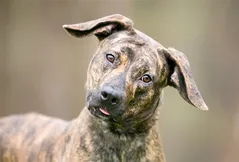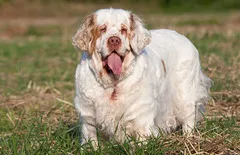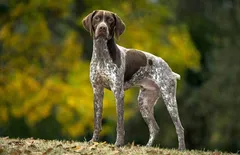
Treeing Walker Coonhound
Treeing Walker Coonhounds thrive on attention and require a large degree of human companionship. He is friendly, confident, and very energetic.
Overall Status
| Height | 20 to 27 inches at the shoulder |
| Temperament | Smart, Brave, Courteous |
| Weight | 45 to 80 pounds |
| Life Expectancy | 10 to 13 years |
| Coat Color | Black, Tricolor, White |
| Barking Level | Frequent |
Quick Factors
| Playfulness | |
| Dog Friendly | |
| Exercise Need | |
| Grooming Needs | |
| Strangers Friendly | |
| Family Affectionate |
Daily Care
Grooming Tips
Moderate, year-round shedders, the Treeing Walker Coonhound needs weekly brushing to remove loose and dead hair. Baths are required as needed, and this depends upon the individual dog's activity level and propensity for flopping in the mud.Check the ears on a weekly basis for signs of infection, irritation, or wax build up. This is of particular importance because the heavy ears of the Walker Coonhound don't allow for proper air circulation, making the breed prone to painful infections.Cleanse regularly with a veterinarian-approved cleanser and cotton ball. Brush the teeth at least once per week to prevent tartar buildup and fight gum disease. Additionally, nails should be trimmed once per month if the dog does not wear the toenails down naturally.
Exercise Tips
Like most coonhounds, the Treeing Walker is a high-energy breed who delights in stretching his legs in a good, long run. He is an excellent candidate for someone who wants a running or hiking companion.While most coonhounds can quite happily become couch potatoes, most will still appreciate long daily walks at a minimum. Romps in the backyard, chasing a ball, or playing with human or canine friends will help to keep him mentally and physically healthy.The Treeing Walker has a very high prey drive and should be on a leash for walks and hikes, as he may be unable to resist the instinct to pursue an interesting scent.
Feeding Tips
Feeding depends on if you’re using your Treeing Walker Coonhound to hunt. He will need higher protein and fat intake in order to aid endurance, energy and muscle mass.If your dog is going to be more of a family pet, then he won’t need as much fat or protein. Whether you’re going with a high-quality dry kibble or a homemade diet, be sure to monitor quantity to match exercise levels.Any diet should be appropriate to the dog’s age (puppy, adult, or senior). A hound who isn’t working can be prone to becomingoverweight, so owners should monitor the dog’s calorie consumption and weight level. Treatscan be an important aid in training, but giving too many can cause obesity. Learn about whichhuman foodsare safe for dogs, and which are not. Check with your vet if you have any concerns about your dog’s weight or diet.Clean, fresh water should be available at all times.
Health Tips
The Treeing Walker is overall quite a healthy breed, andresponsible breedersscreen their stock for health conditions such as hip dysplasia and eye anomalies. Be sure to always check the dog’s ears when he comes in from outside, as ticks love to burrow beneath the coonhound’s floppy ears. Removing excess ear wax and debris and checking the ears at least weekly will help you to avoid common ear infections.
Trainability
This is an intelligent breed, so you’ll find the Treeing Walker Coonhounds easy to train. You’ll need to provide consistent training throughout their lifetime. But you’ll find the process to be as rewarding as he does, as he wants to please you. By using praise and treats as rewards, you’ll be pleased with the outcome. These dogs do not respond to harsh treatment – in fact, it will cause trust issues and may cause your dog to become shy.You’ll find that your Treeing Walker Coonhound will master the basics and will be read to tackle advanced obedience or agility training. This can help use up some of the excess energy these dogs are famous for.
History
The Treeing Walker Coonhound was developed in the Colonial era from crosses ofEnglish Foxhounds. Two breeders from Kentucky, John W. Walker and George Washington Maupin, are given credit for the breed's initial development. The dogs they bred were referred to as Walker Hounds, and were used to hunt raccoons.In the 1800s, a stolen black and tan dog named Tennessee Lead was crossed into the Walker Hound. Tennessee Lead was of unknown origin, but he greatly influenced the Walker. The Walker Coonhound, Treeing, was first recognized by the United Kennel Club (UKC) in 1905 as a part of the English Coonhound breed, at the request of breeders.The name was later changed to Treeing Walker Coonhound, and it was fully recognized as a separate breed in 1945. It was recognized by the American Kennel Club (AKC) in January 2012, making it the AKC's 174th recognized breed.






